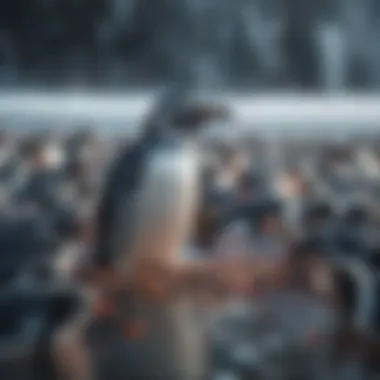Unveiling the Intriguing Diet of Penguins: A Dive into Their Feeding Behaviors


Nature Topic Overview
Penguins, the fascinating flightless birds of the icy Antarctic, possess intricate dietary habits worth exploring. These resilient creatures have adapted specialized feeding behaviors to survive in their harsh environment.
Introduction to Penguins
Overview of Penguin Species
Emperor Penguins
Emperor Penguins, known for their majestic stature and remarkable resilience, are the largest of all penguin species. Their ability to withstand the brutal Antarctic winters symbolizes the epitome of survival in extreme conditions. One key characteristic of Emperor Penguins is their exceptional diving capabilities, allowing them to reach depths that surpass most marine creatures. Despite their impressive physique, Emperor Penguins face challenges such as heightened vulnerability to climate change due to their reliance on sea ice for breeding.
Adelie Penguins
Adelie Penguins, with their distinctive tuxedo-like appearance, are well-suited for life in the Antarctic. These agile hunters rely on their adept swimming skills to catch fish and krill, forming the staple of their diet. Their compact size and energetic nature make them adept at maneuvering through icy waters, allowing them to navigate their icy habitats with ease. However, diminishing sea ice and changes in food availability pose significant threats to Adelie Penguin populations.
Gentoo Penguins
Gentoo Penguins, identified by their striking reddish-orange bills and immaculate white-feathered caps, exhibit a remarkable adaptability that sets them apart. Their preference for milder climates compared to other penguin species enables them to thrive in a variety of regions. Gentoo Penguins' unique feature lies in their curiosity and boldness, often approaching humans with a sense of intrigue. However, competition for nesting sites and food resources presents ongoing challenges to their populations.
Chinstrap Penguins
Chinstrap Penguins, easily identifiable by the narrow black band under their chin, are renowned for their large and densely populated colonies. Their reliance on krill as a primary food source emphasizes their vulnerability to fluctuations in krill populations, influenced by climatic factors and human activities. Despite their resilience to harsh conditions, Chinstrap Penguins undergo considerable stress due to environmental changes that impact their habitat and food availability.
Macaroni Penguins
Macaroni Penguins, named for their distinct yellow crests resembling a macaroni fashion style, tend to inhabit more temperate regions compared to other Antarctic penguin species. Their adept swimming and diving abilities enable them to pursue various prey species, ensuring a diverse diet. However, factors such as overfishing and pollution pose significant threats to their foraging grounds, posing long-term challenges to Macaroni Penguin populations.
Habitats of Penguins
Antarctica
Antarctica, the iconic frozen continent that serves as the primary habitat for several penguin species, embodies a realm of extremes. The harsh, icy landscapes of Antarctica provide a challenging yet vital environment for penguins to thrive. Antarctic penguins' close proximity to nutrient-rich waters facilitates abundant food sources, sustaining their populations. However, increasing temperatures and melting ice pose significant risks to Antarctic penguins, disrupting their foraging patterns and breeding success.
Subantarctic Islands
The Subantarctic Islands, scattered across the Southern Ocean, offer a sanctuary for a diverse array of penguin species. Characterized by rugged terrains and rich biodiversity, these islands provide alternative breeding grounds for some penguin populations. Subantarctic penguins benefit from the rich marine life surrounding these islands, ensuring a stable food supply. Yet, challenges such as invasive species and habitat degradation threaten the delicate equilibrium of these island ecosystems.
Southern South America
Southern South America serves as a significant region for penguin habitats, with species like the Magellanic Penguin thriving along its coasts. The temperate climates of South America provide favorable conditions for penguin breeding and foraging activities. Penguin colonies along the southern coasts of Argentina and Chile rely on abundant fish stocks, emphasizing the interconnectivity between penguin populations and marine ecosystems. However, pollution and overfishing in these regions endanger the delicate balance that sustains penguin communities.
South Africa


South Africa's diverse coastline offers a conducive environment for penguin species such as the African Penguin. Known for their distinctive braying calls and sleek adaptations for swimming, African Penguins navigate the coastal waters of South Africa with finesse. However, pollution, habitat loss, and overfishing threaten the sustainability of penguin habitats along South Africa's shores, underscoring the urgent need for conservation efforts to safeguard these unique avian residents.
Australia, New Zealand, and Oceania
Penguin species like the Little Blue Penguin find sanctuary in Australia, New Zealand, and the Oceania region, where temperate climates and abundant marine resources sustain their populations. The rocky coasts and sheltered bays of these regions provide secure nesting sites for penguins to raise their young. Despite conservation efforts, penguin species in Australia, New Zealand, and Oceania face escalating challenges from marine pollution, climate change, and habitat encroachment, necessitating proactive measures to ensure their long-term survival.
Penguin Feeding Behaviors
Penguin Feeding Behaviors are crucial in understanding the diet of these intriguing birds. Their ability to dive deep and forage efficiently plays a vital role in their survival within the harsh Antarctic environment. By exploring specific elements like deep diving abilities, hunting strategies, schooling behavior, and group feeding, we can uncover the intricate mechanisms that dictate penguins' feeding habits and overall well-being.
Diving and Foraging Techniques
Deep Diving Abilities
Deep Diving Abilities in penguins showcase their unique adaptation for seeking food sources at great depths. This specialized characteristic allows penguins to access a wider range of prey that other surface-feeding birds cannot reach. The efficiency of deep diving abilities enhances their foraging success and ensures a diverse diet, making it a cornerstone of their feeding behaviors.
Hunting Strategies
Penguins' Hunting Strategies demonstrate their adeptness in capturing prey during underwater pursuits. Their strategic approach optimizes energy expenditure and maximizes catch efficiency. This behavior aids in meeting their daily nutritional requirements and ensures their survival in the competitive marine environment, highlighting the effectiveness of their hunting strategies.
Schooling Behavior
Schooling Behavior in penguins involves working as a cohesive group to herd fish and other prey species, increasing the chances of successful feeding for all individuals involved. This collective effort not only facilitates efficient foraging but also strengthens social bonds within the penguin community. The cooperative nature of schooling behavior is a testament to penguins' adaptive strategies in obtaining sustenance.
Group Feeding
Group Feeding among penguins amplifies their foraging capabilities by creating a commotion that confuses prey, making it easier for penguins to capture food. This collaborative feeding technique benefits the entire group by ensuring an equitable distribution of resources and fostering solidarity among colony members. The synergistic nature of group feeding underscores the interdependence and cooperation essential for penguins' dietary success.
Feeding Frequencies
Daily Feeding Cycles
Penguins' Daily Feeding Cycles revolve around optimizing their energy expenditure and nutritional intake to sustain their daily activities. These carefully timed feeding routines align with penguins' natural behavioral patterns, ensuring they acquire sufficient nourishment while balancing their energy reserves effectively. The consistency of daily feeding cycles underscores the discipline and adaptability inherent in penguins' feeding behaviors.
Feeding During Mating Seasons
During mating seasons, penguins adjust their feeding behaviors to support the demands of breeding and caring for offspring. The specialized feeding patterns adopted during this period prioritize nutrient-rich food sources to meet the increased energy requirements for successful reproduction. Adapting their diet according to mating seasons reflects penguins' remarkable ability to align feeding behaviors with reproductive needs.
Chick Feeding Patterns
Chick Feeding Patterns highlight the parental care and feeding strategies employed by adult penguins to nurture their young. The selective provisioning of food ensures optimal growth and development of penguin chicks, emphasizing the importance of specific nutrients in their early stages of life. The precise nature of chick feeding patterns underscores penguins' dedication to offspring survival and the continuity of their species.
Types of Food Consumed by Penguins
Fish Species


Antarctic Silverfish
Antarctic Silverfish is a key component of the penguin diet, offering essential nutrients and energy for these birds. Its high protein content makes it a vital food choice for penguins, aiding in their growth and overall health. The Antarctic Silverfish's abundance in the region makes it a reliable food source for penguins, supporting their dietary needs effectively.
Mackerel Icefish
Mackerel Icefish is another significant food source for penguins due to its nutrient-rich composition. Its high omega-3 fatty acids content benefits penguins by providing them with essential fats for energy and insulation in the cold Antarctic waters. Penguins rely on Mackerel Icefish as a staple in their diet, showcasing its importance in sustaining their health and well-being.
Krill
Krill represents a vital part of the penguin diet, offering a source of protein, fats, and antioxidants. Penguins consume Krill in large quantities, benefiting from its nutritional value and energy content. The abundance of Krill in the Antarctic waters serves as a fundamental food source for penguins, aiding in their overall dietary requirements.
Sardines
Sardines play a significant role in the penguin diet, providing essential nutrients such as omega-3 fatty acids and vitamins. Penguins include Sardines in their diet to enhance their immunity and maintain a balanced nutritional intake. The availability of Sardines in the penguin's habitat supports their dietary diversity and contributes to their health.
Crustaceans and Squid
Antarctic Krill
Antarctic Krill serves as a crucial component of the penguin diet, offering a source of proteins and fats essential for their well-being. Penguins rely on Antarctic Krill for its abundance and nutritional value, ensuring their dietary requirements are met in the challenging Antarctic environment.
Giant Squid
Giant Squid is a significant food source for penguins, providing a substantial source of proteins and minerals. Penguins consume Giant Squid to fulfill their nutritional needs and enhance their diet diversity. The consumption of Giant Squid by penguins showcases their adaptability and resourcefulness in obtaining food sources in their ecosystem.
Cephalopods
Cephalopods are an important food choice for penguins, offering a blend of proteins and omega-3 fatty acids. Penguins incorporate Cephalopods into their diet to maintain their energy levels and support their growth. The variety of nutrients present in Cephalopods contributes to the overall health and vitality of penguins.
Lanternfish
Lanternfish serves as a valuable food source for penguins, providing essential nutrients like fats and vitamins. Penguins rely on Lanternfish to supplement their nutritional intake and adapt to the changing dietary conditions in the Antarctic waters. The consumption of Lanternfish by penguins reflects their ability to utilize different food sources for their sustenance.
Specialized Diets and Adaptations
Specialized Diets and Adaptations play a crucial role in understanding the dietary habits of penguins in their natural habitats. Penguins exhibit a remarkable ability to adapt their diets based on seasonal variations and nutritional requirements to ensure their survival in the harsh Antarctic environment. This section will delve into the specific elements of specialized diets and adaptations, highlighting how these unique feeding strategies contribute to the overall well-being and sustainability of penguin populations.
Seasonal Variations in Diet
Summer Feeding Patterns
Summer feeding patterns are a vital aspect of penguin behavior during the warmer months. Penguins alter their diet to capitalize on the increased availability of food sources such as fish, krill, and squid. This strategic shift in feeding patterns allows penguins to consume nutrient-rich prey, essential for maintaining energy levels and supporting breeding activities. The adaptability of penguins in adjusting their diet according to seasonal changes is a testament to their resilience in the challenging Antarctic ecosystem.
Winter Dietary Adjustments


Winter brings unique challenges for penguins, as food sources become scarce due to freezing conditions. Penguins' winter dietary adjustments involve conserving energy by reducing their metabolic rate and relying on fat stores accumulated during the summer months. This adaptation allows penguins to survive the harsh winter period when hunting opportunities are limited. Despite the challenges posed by winter, penguins' ability to adapt their diet underscores their remarkable physiological adaptations to extreme environmental conditions.
Breeding Season Diet Changes
Breeding season diet changes are essential for penguins to sustain themselves and their chicks during this critical period. Penguins prioritize high-energy foods to support the demanding breeding activities, including nest-building, egg incubation, and chick rearing. The shift towards a more energy-dense diet during the breeding season reflects penguins' effective resource management and parental care strategies. By adjusting their diet to meet the specific energy requirements of breeding, penguins ensure the successful continuation of their species.
Nutritional Requirements
High-Fat Diet for Energy
A high-fat diet plays a significant role in providing penguins with the necessary energy reserves to withstand the harsh Antarctic conditions. Penguins rely on fat-rich prey such as fish and krill to fuel their metabolism and maintain their core body temperature in cold environments. This dietary preference for high-fat foods aligns with penguins' energy requirements for long foraging trips and thermoregulation, highlighting the importance of fat in their nutritional intake.
Protein-Rich Foods
Protein-rich foods are essential for penguins' growth, development, and overall health. Penguins consume a variety of protein sources, including fish and squid, to support muscle function and tissue repair. The high protein content in their diet aids in feather maintenance, organ function, and immune response, crucial for penguins' survival in challenging habitats. By prioritizing protein-rich foods, penguins ensure adequate nutrient intake for optimal physiological function.
Vitamins and Minerals Intake
Vitamins and minerals are vital components of penguins' diet, contributing to various physiological processes and immune function. Penguins acquire essential vitamins like A, D, and E from their diet of fish and crustaceans. Minerals such as calcium and iron play critical roles in bone formation, blood clotting, and oxygen transport in penguins. The balanced intake of vitamins and minerals supports penguins' overall health and enables their successful adaptation to the nutrient-rich Antarctic ecosystem.
Impact of Climate Change on Penguin Diets
Climate change is a crucial factor influencing the dietary habits of penguins. As the environment shifts, penguins face challenges in finding their usual food sources due to changes in prey populations, competition for resources, and alterations in migration patterns. These changes have significant implications for penguin populations, leading to adaptations and adjustments in their feeding behaviors to cope with the evolving conditions.
Altered Food Availability
Shifts in Prey Populations
Shifts in prey populations have a direct impact on the diet of penguins. The availability of certain fish species or crustaceans can fluctuate due to climate change, affecting the traditional food sources of penguins. This alteration in prey populations forces penguins to adapt their foraging patterns and explore alternative food options to meet their nutritional needs.
Competition for Resources
The escalating competition for resources among penguins arises from the dwindling food supply caused by climate change. With changing food availability, penguins must compete more fiercely for limited resources, leading to potential conflicts and challenges in sustaining their dietary requirements. This increased competition poses a threat to the overall health and survival of penguin populations.
Migration Patterns
Changes in migration patterns impact the distribution of penguin colonies and their access to diverse feeding grounds. Climate change can alter the timing and routes of penguin migrations, affecting their ability to reach optimal foraging locations. Disrupted migration patterns may result in penguins facing longer distances to find food, increased energy expenditure, and reduced breeding success due to inadequate nutrition.
Consequences for Penguin Populations
Population Declines
Population declines among penguins can be a consequence of climate change-induced challenges in food availability and competition. As the struggle for resources intensifies, some penguin species may experience a decline in population numbers, endangering their survival. Reduced food availability leads to malnutrition, lower reproductive rates, and increased vulnerability to environmental threats.
Breeding Challenges
Breeding challenges emerge when penguins face difficulties in procuring sufficient food for themselves and their chicks. Inadequate nutrition due to climate change impacts can result in delayed breeding cycles, decreased chick survival rates, and compromised reproductive success. These challenges underscore the delicate balance between food availability and successful breeding among penguin colonies.
Adaptation Strategies
Penguins employ various adaptation strategies to mitigate the effects of climate change on their diets. These strategies include adjusting their foraging behaviors, exploring new feeding grounds, and modifying their diet compositions to account for changing prey availability. By adapting to the shifting environmental conditions, penguins demonstrate resilience and flexibility in navigating the challenges posed by climate change on their dietary requirements.







